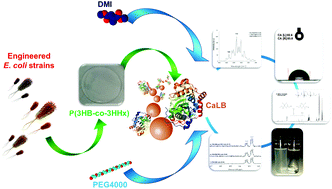Enzymatic production of clickable and PEGylated recombinant polyhydroxyalkanoates†
Abstract
Polyhydroxyalkanoates (PHAs) are microbial polyesters attracting great attention while further functionalisation could widen their applicability. Various Escherichia coli based production systems using the PHA biosynthetic operon from Bacillus cereus 6E/2 were designed to enhance the accumulation of PHAs with high medium chain length moieties. Media optimization and system engineering were applied, yielding the production of PHAs up to 260 mg L−1. Polymer characterization revealed a low grade of crystallinity and remarkable hydrophobic features. For further functionalization, a novel enzyme based strategy was developed. Lipase B from Candida antarctica (CaLB) was used to catalyze the terminal coupling of PHAs with: (i) dimethyl itaconate (DMI) in order to introduce reactive side chain vinyl moieties for the easy coupling of functional molecules and/or (ii) biocompatible polyethylene glycol (PEG) to tune polymer hydrophilicity. The functionalized DMI–PHA, PEG–PHA and PEG–DMI–PHA polymers obtained and characterised by NMR, GPC, FT-IR, and WCA in this study open new perspectives on the use of PHAs as biodegradable and biocompatible materials of choice for biomedical applications.



 Please wait while we load your content...
Please wait while we load your content...